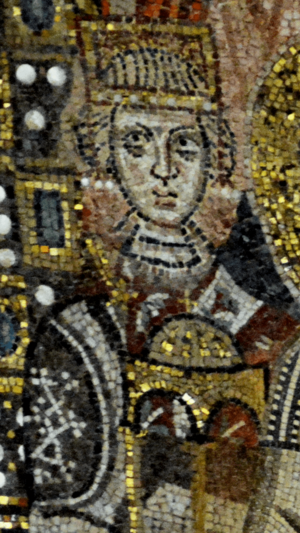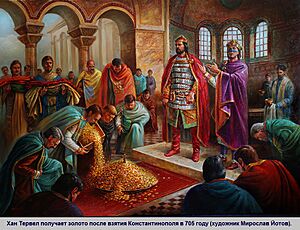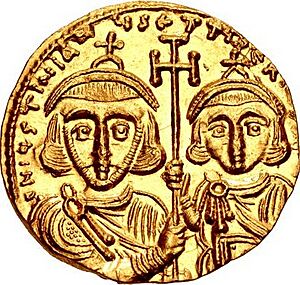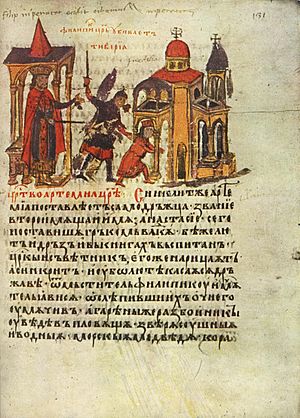Justinian II facts for kids
Quick facts for kids Justinian II |
|||||
|---|---|---|---|---|---|
| Emperor of the Romans | |||||

Young Justinian II, mosaic in the Basilica of Sant'Apollinare in Classe, Ravenna.
|
|||||
| Byzantine emperor | |||||
| 1st reign | 10 July 685 – 695 | ||||
| Predecessor | Constantine IV | ||||
| Successor | Leontius | ||||
| 2nd reign | 21 August 705 – 4 November 711 |
||||
| Predecessor | Tiberius III | ||||
| Successor | Philippicus | ||||
| Co-emperor | Tiberius (706–711) | ||||
| Born | 668 or 669 Constantinople |
||||
| Died | 4 November 711 (aged 42) Damatrys, Opsikion |
||||
| Spouse | Eudokia Theodora of Khazaria |
||||
| Issue | Anastasia Tiberius |
||||
|
|||||
| Dynasty | Heraclian | ||||
| Father | Constantine IV | ||||
| Mother | Anastasia | ||||
| Religion | Chalcedonian Christianity | ||||
Justinian II (born 668 or 669, died 711) was a Byzantine emperor. He was the last ruler from the Heraclian dynasty. Justinian II ruled twice: first from 685 to 695, and then again from 705 to 711.
Like his famous ancestor, Justinian I, he was very ambitious. He wanted to bring the Roman Empire back to its former glory. However, Justinian II was also known for being very harsh to anyone who disagreed with him. This made many people unhappy. In 695, a large uprising removed him from power. He only got his throne back in 705 with help from armies from Bulgaria and Slavic tribes. His second time as emperor was even stricter. In 711, soldiers who rebelled against him killed him.
Contents
Becoming Emperor for the First Time
Justinian II was the oldest son of Emperor Constantine IV and Anastasia. His father named him as his heir in 681. This happened after his uncles, Heraclius and Tiberius, were removed from power. In 685, when he was just sixteen years old, Justinian II became the sole emperor.
When Justinian became emperor, the eastern parts of the empire were peaceful. This was thanks to his father's victories. Justinian attacked the Arabs in Armenia. He then managed to make the Umayyad Caliphs pay more money to the empire each year. He also got back control of part of Cyprus. The money from Armenia and Iberia was shared between the two empires.
In 687, Justinian moved about 12,000 Christian Maronites from Lebanon. They had often fought against the Arabs. He also moved other groups, like the Mardaites and people from Cyprus. This helped him make his navy stronger. In 688, Justinian made a deal with the Caliph Abd al-Malik ibn Marwan. They agreed that Cyprus would be neutral, and its taxes would be split.
Campaigns in the Balkans
With peace in the east, Justinian could focus on the Balkans. Many areas there had been taken over by Slavic tribes. In 687, Justinian moved soldiers from Anatolia to Thrace. He led a big military campaign in 688–689. He defeated the Slavs in Macedonia. He was finally able to reach Thessalonica, which was the second most important Byzantine city in Europe.
The defeated Slavs were moved to Anatolia. There, they were meant to become a large part of his army, about 30,000 men. Feeling stronger, Justinian started fighting the Arabs again. He won a battle in Armenia in 693. But the Arabs bribed his new Slavic army to switch sides. Most of the Slavic soldiers left during the Battle of Sebastopolis. Justinian was completely defeated and had to run away.
According to a historian named Theophanes, Justinian was so angry. He ordered many Slavs in and around Opsikion to be killed. Meanwhile, a leader named Symbatius rebelled in Armenia. He opened the area to the Arabs, who then took control of it in 694–695.
Challenges at Home
At home, Justinian treated followers of Manichaeism very harshly. He also tried to stop popular traditions that were not part of the main Christian church. This caused problems within the Church. In 692, Justinian called a meeting called the Quinisext Council in Constantinople. He wanted to make his religious rules official.
This Council made new rules and clarified old ones. But it also highlighted differences between the Eastern and Western churches. For example, Eastern priests could marry, but Western priests could not. This made relations with the Catholic Church difficult. The emperor even ordered Pope Sergius I to be arrested. But the people of Rome and Ravenna supported the Pope and rebelled.
Justinian also helped develop the theme system of the empire. This system divided the empire into military districts. He created a new theme called Hellas in southern Greece. He also made the leaders of the four main themes important government officials. He tried to protect the rights of free farmers. These farmers were important for the army. He wanted to stop rich landowners from taking their land. This put him against some of the most powerful people in the empire.
While his land policies upset the rich, his tax policies made ordinary people very unhappy. Justinian used his agents, Stephen and Theodotos, to collect a lot of money. He wanted to pay for his expensive tastes and build many grand buildings. This, along with religious disagreements and conflicts with the rich, led to a rebellion. In 695, the people rose up. A general named Leontius became their leader and was declared emperor. Justinian was removed from power and sent away to Cherson in the Crimea. This was to stop him from trying to get his throne back. Leontius ruled for three years. Then, he was also removed and imprisoned by Apsimarus, who became the new emperor.
Life in Exile
While in exile, Justinian started making plans to get his throne back. He gathered people who supported him. Justinian became a problem for the authorities in Cherson. They decided to send him back to Constantinople in 702 or 703. But he escaped from Cherson. He received help from Busir, the leader of the Khazars. Busir welcomed him and gave him his sister to marry. Justinian renamed her Theodora, after the wife of Justinian I. They lived in the town of Phanagoria.
Emperor Tiberius offered Busir money to kill Justinian. Busir sent two Khazar officials, Papatzys and Balgitzin, to do it. But Justinian's wife warned him. Justinian then killed Papatzys and Balgitzin. He sailed in a fishing boat to Cherson. He gathered his supporters, and they all sailed across the Black Sea.
As Justinian's ship sailed, a big storm hit them. It was somewhere between the Dniester and Dnieper Rivers. During the storm, one of his friends told Justinian that if he promised God not to seek revenge on his enemies, they would be saved. Justinian replied: "If I spare a single one of them, may God drown me here."
After surviving the storm, Justinian went to Tervel of Bulgaria. Tervel agreed to help Justinian get his throne back. In return, Justinian promised him money, a special title called Caesar, and his daughter Anastasia's hand in marriage. In the spring of 705, Justinian arrived outside Constantinople with an army of 15,000 Bulgar and Slav horsemen.
For three days, Justinian tried to convince the people of Constantinople to open the city gates. But they would not. Since he couldn't take the city by force, he and some friends found an unused water pipe under the city walls. They entered through it, gathered their supporters, and took control of the city in a surprise attack at midnight. On August 21, Justinian became emperor again. He found his rivals, Leontius and Tiberius, and had them executed. Many of their supporters were also killed. He also removed, blinded, and sent Patriarch Callinicus I to Rome.
Second Time as Emperor
Justinian's second time as emperor was marked by wars that he didn't win. He fought against Bulgaria and the Caliphate. He also harshly punished people who opposed him at home. In 708, Justinian attacked Bulgarian Khan Tervel, whom he had made a caesar earlier. He wanted to get back the lands he had given to Tervel in 705. The emperor was defeated and forced to retreat. Peace between Bulgaria and Byzantium was quickly restored. After this defeat, the Arabs won battles in Asia Minor. Cities in Cilicia fell to the enemy, and they entered Cappadocia in 709–711.
He ordered Pope John VII to accept the decisions of the Quinisext Council. At the same time, he sent a military force to Ravenna in 709. This force was led by Theodore. The goal was to make Ravenna obey the Western Church's authority again. Ravenna was seen as disobedient to the emperor. The mission was successful. The new Pope Constantine visited Constantinople in 710. Justinian renewed all the special rights of the Roman Church. We don't know exactly what they discussed about the Quinisext Council. But it seems Pope Constantine approved most of its rules. This was the last time a Pope visited Constantinople until Pope Paul VI visited Istanbul in 1967.
Justinian's rule caused another rebellion against him. Cherson revolted. The exiled general Bardanes led the city and held out against an attack. Soon, the soldiers sent to stop the rebellion joined it. The rebels then took the capital city and declared Bardanes as Emperor Philippicus. Justinian was on his way to Armenia and couldn't get back to Constantinople in time to defend it. He was arrested and executed in November 711. His head was shown in Rome and Ravenna.
When Justinian's mother heard about his death, she took his six-year-old son, Tiberius. Tiberius was also a co-emperor. She took him to a safe place at St. Mary's Church in Blachernae. But Philippicus's men followed her. They dragged the child from the altar and killed him outside the church. This ended the family line of Heraclius.
His Legacy
| Justinian II | |
|---|---|

Justinian II Solidus
|
|
| Emperor | |
| Honored in | Eastern Orthodox Church |
| Feast | 2 August |
Justinian's time as emperor saw the Byzantine Empire slowly change. Old traditions from the ancient Roman state were gradually fading away. This can be seen in his coins. He brought back the Loros, a traditional costume for consuls, which hadn't been on coins for a century. He also decided to combine the job of consul with that of emperor. This made the emperor the official head of state. Although the title of consul existed until Emperor Leo VI the Wise officially ended it, Justinian effectively stopped it from being a separate political role. He was formally appointed Consul in 686.
Even though his harsh ways sometimes caused problems, Justinian was a smart and talented ruler. He managed to improve the standing of the Byzantine Empire. He was a religious ruler. Justinian was the first emperor to put an image of Christ on coins. He also tried to ban old pagan festivals and practices that still existed in the empire. He may have tried to be like his famous ancestor, Justinian I. This is seen in his love for big building projects. He also renamed his Khazar wife Theodora, just like Justinian I's wife. Some of his building projects included an extension to the imperial palace and a new Church of the Virgin.
Justinian II is sometimes honored as a saint in the Orthodox Church. However, there is some confusion about this. Different old texts have different information. Some mention "Emperor Justinian" without saying if it's Justinian I or II. Some modern translations and Greek texts list Justinian I on August 2. Others don't mention either. But some Greek texts do list Justinian II.
Family Life
With his first wife, Eudokia, Justinian II had at least one daughter named Anastasia. She was promised in marriage to the Bulgarian ruler Tervel. With his second wife, Theodora of Khazaria, Justinian II had a son named Tiberius. Tiberius was a co-emperor with his father from 706 to 711.
In Fiction
The 1998 novel Justinian by Harry Turtledove tells a made-up story about Justinian's life. It's told by a fictional soldier who was his lifelong friend. In the book, Turtledove imagines that Justinian had surgery on his nose while in exile.
See also
 In Spanish: Justiniano II para niños
In Spanish: Justiniano II para niños
- 7th century in Lebanon § 680s
- List of Byzantine emperors




